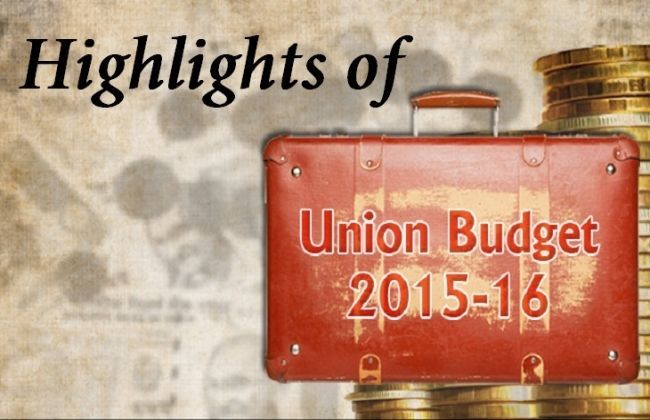As the 2016 Union Budget is getting closer, let's have a quick look back into what the last year's budget had up its arms for the automotive industry and how the 2015 Budget has helped the automotive industry.
The 2015 Union Budget was the first full-term budget of the new government and the automotive industry was very optimistic about it, with a hope that more share of the pie was likely to be consumed by it.
Implementation of Goods and Service Tax (GST), lowering interest rates on vehicles, lowering excise duty on vehicles, etc. were some of the primary demands raised by the automotive sector, which could have brought a persistent growth in the automotive industry. However, except for announcement for implementation of GST, most other demands were not even addressed in the last budget (except for a few which though have indirectly benefited the industry, yet the results are not immediate). The Budget did not announce any measures that could have boosted the automotive industry or have encouraged R&D in this sector.

Some of the primary expectations which remained unfulfilled from the 2015 Budget are:
Lowering Excise duty
The major demand of all the automakers was lower excise duty benefit. However, to everyone’s surprise, the excise duty benefit, which was included by the previous government in its interim budget, was withdrawn and the duty was increased back to its original structure from January 2015 by the current government. The lowered excise duty (SUVs - reduced to 24% from 30%, mid-sized cars - reduced to 20% from 24%, large cars - reduced to 24% from 27 per cent) had benefited the customers through decreased prices but the prices again soared post the cancellation of the duty benefit in January 2015.
Further, though the education cess and secondary and higher education cess on excise duty were abolished (subsumed in the consolidated rate), the overall excise duty rate was marginally increased as opposed to the industry's expectation for lowering of excise duty.
Implementation of GST
Another expectation was an early implementation of GST regime which could not only have simplified the current indirect tax structure and created a uniform tax structure across all states, but also have resulted in improving the credit chain and eliminated the cascading effect of taxation, in turn reducing the prices to the ultimate consumers.
When it was announced in the 2015 Budget that the GST Bill would be introduced by April 2016, the auto industry sighed a relief. But that was short lived too as the government has failed to pass the GST Bill through Parliament, making the April 2016 target impossible.
Reducing interest rate on automobiles
Auto manufacturers also had high hopes on the budget for a decrease in the auto loan interest rates. As is with the interest on home loans, tax incentives for interest on auto loans (as in the case of housing loans) were expected to be introduced to stimulate the demand for automobiles. Lower the individual tax incidence, higher the quantum of income at disposal and this could have boosted the demand, especially for small car and two wheeler segments.
But this matter also went unaddressed in the 2015 budget; though in June 2015, RBI announced a reduction in repo rate that boosted the buyer’s sentiments.
Custom Duty
Commercial vehicle industry too got a big blow to the gut with the customs duty on commercial vehicles being increased from 10% to 40%, directly affecting business for major players such as Ashok Leyland, Eicher motors, Force Motors and Tata Motors.
Also, the long standing demand to remove the differentiation between the CKD and SKD form also remained unheard.
All was not lost though. The 2015 Budget did extend certain benefits to the automotive industry as well. Some of these are:
Benefit to Electric Vehicle segment
The 2015 budget had some tricks up its sleeves for electric and hybrid vehicle manufacturers. The excise duty was waived for electric and hybrid vehicles and the government also announced Rs.75 crore for Electric Vehicle and hybrid vehicle manufacturers to give an impetus to this industry.
Moreover, the concessions from customs and excise duties available on specified parts for manufacture of electrically vehicles and hybrid vehicles were extended for more year or till the end of March 2016.
Import of technology
Another positive move in 2015 Budget that acted as a huge impetus to the technological advancement in the industry was reduction in tax rate (from 25% to 10%) on royalty and fees for technical services paid to a non-resident. Together with the "Make in India" campaign, this resulted in lower cost of technology, providing a level playing field to the domestic player.
Conclusion
If the primary benefits were introduced by the 2015 Budget, the industry would have benefited more; nevertheless, there were some indirect positives including GST implementation announcement, significant increase in allocation of funds towards development of infrastructure and reduction in corporate tax rate from 30% to 25% over the next 4 years.
Though not a lot of significant changes specific to the auto sector were announced, the overall growth of the economy have benefited the auto sector. Several spokespersons from leading automotive companies welcomed the 2015 Union Budget terming the budget had a focus on long-term growth of the country and showed their support for the GST Bill.
Imperative to say, government needs to introduce more reforms to make the environment conducive for the automotive industry.
That was what happened for the automotive industry in the 2015 Union Budget. Let’s hope the forthcoming budget provides more support to the consumers and right impetus to the automotive industry.


